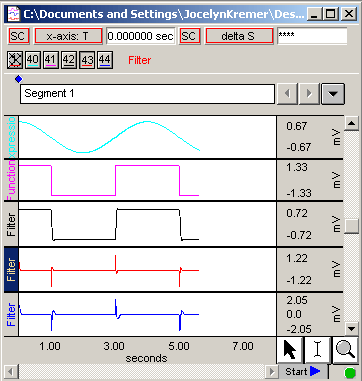H20 Filtering

This PRO Lesson describes how to design and develop software-based digital filters to perform a variety of physiological signal filtering tasks and cascade 2nd-order biquads to create high order filters. All data collection and analysis is done via the BIOPAC MP3X data acquisition unit and the Biopac Student Lab PRO software.
Experimental Objectives
- Generate Filter Step Response signals.
- Generate the Filter Transfer Function.
- Verify the Filter Transfer Function using sine waves.
- Create a cascaded (dual biquad) filter to optimize the physiological recording of ECG.
Tasks Performed by the Student
- Review the template channels and, if desired, view parameters.
- CH 1 Input: not plotted
- C1 (CH 40): 0.25 Hz Sine
- C2 (CH 41): 0.25 Hz Square, source=C1
- C3 (CH 42): 10 Hz LP, source=C2
- C4 (CH 43): 10 Hz HP, source=C2
-
C5 (CH 44): 5-50 Hz BP, source=C2
-
Record for at least 5 seconds.
Videos
Biopac Student Lab Student Download
Student Prep & Distance Learning
Click the link(s) below for sample data and/or lesson procedure video(s), BSL PRO Lesson procedures (PDF) for human lessons*, and graph template files (*.gtl) for BSL PRO Lessons. If more than one .gtl is available, download the .gtl with the _suffix to match BSL version and hardware.
Lesson Hardware
This lesson requires a Biopac Student Lab (BSL) System and the following hardware. If your BSL System does not include all hardware items, expand your system by selecting required items below. For more details, review the Lesson: L# BSL Lessons - see the Lab Manual or launch BSL; A# and H# BSL PRO Lessons, click the PDF link above to review full setup, recording, and analysis procedures.
Stay Connected